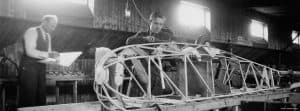The Lavin Agency Speakers Bureau
A speakers bureau that represents the best original thinkers,
writers, and doers for speaking engagements.
A speakers bureau that represents the best original thinkers,
writers, and doers for speaking engagements.
The third way of innovation is not radical disruption—it’s a low-risk, high-reward strategy.
We tend to imagine innovation as slow, incremental change or else industry-shifting disruption. Yet for most companies, neither works. In The Power of Little Ideas, MIT Sloan professor DAVID ROBERTSON outlines a third way of innovation—actual working strategies for world-class companies. Building on his groundbreaking study of Lego’s rise from near-bankruptcy, Robertson shows us the organizational practices that lead to sustained innovation.
“The story of how Lego came perilously close to disaster but then transformed itself into one of the most successful and innovative companies in the world serves both as an inspiration and an object lesson.” — Chris Anderson, author of The Long Tail
David Robertson has devoted his life to innovation, having studied, taught, and practiced the art of organizational change throughout his career. In his book The Power of Little Ideas, Robertson argues for a ‘third way’ of innovation: something between slow, incremental change and radical disruption. Instead, he champions a low-risk, high-reward strategy that calls for complementary innovations around a core product or service. As he explains, companies like Gatorade, Wegman’s, Novo Nordisk, Lego, Victoria’s Secret, and others were either tired, second to market, challenged by tough competition, or on their way to becoming a commodity. But each was able to expand and recover spectacularly by innovating around the box—creating ecosystems of products that made their central product or service irresistible to customers. Little Ideas is powerful, practical, cogent and necessary—and Robertson translates this transformative book into refreshingly useful keynotes.
In his previous book Brick by Brick, Robertson gave the definitive account of one of the most profound business transformations in recent memory. In 2003, Lego almost went bankrupt. The company failed to adapt to the revolutionary changes in children’s lives and began sliding into irrelevance. Advice from innovation experts almost led the company to ruin, and the future looked bleak for one of America’s most iconic brands. Why didn’t newly developed products and businesses—including theme parks, computer games, electronic toys, and clothing—save the company? The answer wasn’t just innovation—it was innovation management. Lego needed an entirely new system of processes, tools, roles, and policies that governed creative thinking. Once that was in place, the company re-emerged more powerful, resilient, and inventive than ever. Throughout Brick by Brick—named one of the Best Books of the Year by Fortune and Strategy + Business—Robertson presents the strategies Lego used to become a customer-driven, full-spectrum, open, and adventurous brand. “Any manager can learn from these lessons,” writes Forbes. And in his funny, fascinating, and often interactive talks, he makes Lego’s success a case study any company can use to grow and evolve—and become iconic.
Today, Robertson is a Senior Lecturer at MIT Sloan School of Management, where he teaches Product Development and Digital Product Management. Previously, he was a Professor of Practice at the Wharton School, where he hosted the podcast Innovation Navigation, in addition to teaching. He was previously a LEGO Professor of Innovation and Technology Management at Switzerland’s Institute for Management Development (IMD), which received the #1 worldwide ranking by The Financial Times for its executive education programs. Robertson currently serves as a consultant to companies on innovation and technology management issues. He holds a PhD from the MIT Sloan School.
David's talk stood out as one of the highlights of the event. One attendee said, "The Lego segment was outstanding. I could see the correlation of customer-centric vision and delivery of professional empowerment for all our customers. Bravo!"
IntuitI wanted to send a note of sincere thanks for speaking at our Automation Fair event this year. Throughout the week, I've received numerous positive comments on your session: attendees shared that innovating around the box is a simple yet invaluable concept, and there was much discussion around lessons learned by LEGO and Apple. We recognize the time and effort that go into this level of presentation. Once again, thank you for sharing your expertise with our audience.
Rockwell AutomationDavid was able to tailor his talk to our group and facilitate an exercise after his talk that applied the ideas from his book to real issues that we're facing today. His talk was entertaining and thought-provoking, and the exercise after really helped to bring the lessons home to our group and apply the ideas from his books to our business.
Nouryon
Founding President, PlusCo Venture Studio Former Chief Creative and Innovation Officer, Cossette

Instant New York Times Bestselling Author of Empire of AI TIME100 AI Honoree Lead Designer of The Pulitzer Center's AI Spotlight Series
Author of The Age of Cryptocurrency and Our Biggest Fight Co-Host of the Money Reimagined Podcast MIT Media Advisor

Author of The Loop: How A.I. is Creating a World without Choices and How to Fight Back NBC News Technology Correspondent Former Editor-in-Chief of Popular Science Magazine AI Strategic Advisor to Fortune 500 Companies

Founding President, PlusCo Venture Studio Former Chief Creative and Innovation Officer, Cossette

Historian New York Times Bestselling Author of Humankind: A Hopeful History, Utopia for Realists, and Moral Ambition

Author of Grit, the #1 New York Times Bestseller | Pioneering Researcher on Grit, Perseverance, and the Science of Success

2024 Nobel Prize Winner | 3rd Most Cited Economist in the World | Bestselling Co-Author of Why Nations Fail and Power and Progress

Harvard Business School Behavioral Science Professor | "40 Under 40 MBA Professor" | Author of TALK: The Science of Conversation and the Art of Being Ourselves

#1 New York Times Bestselling Co-Author of Abundance | Host of thePlain English Podcast | Founder of the Substack Derek Thompson

#1 New York Times Bestselling Author of How the Word Is Passed and Above Ground | The Atlantic Staff Writer

AI has already transformed what we do. The next stage is how it will transform the way we create: new products, new services, new processes, new ideas, new ways of thinking.
In this provocative and practical keynote, MIT innovation expert David Robertson reveals how AI will transform how we innovate and what the future of our businesses looks like. Success in this new era won’t just be about changing what we build—it’ll be about changing how we build it.
Innovation has always evolved. From Polaroid’s “scheduling invention” approach to the rise of stage-gate processes to the Design Thinking revolution, every major leap forward has redefined what innovation looks like. And today, we’re standing at the edge of the next big shift. At MIT, Robertson and his team have built a groundbreaking multi-agent AI platform that supercharges the entire way companies generate, refine, and select ideas.
In this fast-paced session, Robertson takes you on a whirlwind tour through the history of innovation methods—then shows you what’s coming next. And in the hands-on workshop that follows, your team will dive straight into MIT’s new AI platform, learning exactly how to use it to tackle your biggest innovation challenges.
Perfect for executive teams, R&D leaders, strategy groups, and innovation professionals who need to stay two steps ahead, this keynote + workshop experience gives you:
The future of innovation isn’t just about making better products. It’s about reinventing how we invent. Get ready to disrupt the process—before your competitors do.

Today, companies are often caught between two ways of ‘doing’ innovation. The first involves the incremental improvement of existing products, or simply spinning out another variant—but that rarely means breakthrough success. And the second means a radical, revolutionary disruption of your entire industry. But while thrilling, this is of course high-cost, high-risk, and rarely applicable for most organizations.
Now, in a talk based on his book The Power of Little Ideas, David Robertson outlines a third way. Rather than thinking too narrowly, or too disruptively, great companies innovate around the box. This means surrounding your key products—what made you great in the first place—with complementary innovations, or a supportive ecosystem of goods that broaden your appeal but don’t alter your central services or values. Gatorade did it by offering products meant for consumption before, during, and after performance—not by extending its range of flavored drinks. Victoria’s Secret did it by expanding into swimwear, CDs, fragrances and toiletries—not by releasing yet another bra. With reference to these, and other companies that get it—Disney, GoPro, Red Bull, Apple, Amazon, LEGO, and more—Robertson outlines the profound changes you’ll need to make to your internal processes, structure, rewards, roles, and systems to pull it off. Innovation can be logical, sustainable, and reliable. And with Robertson, you can foster a low-risk, high-reward strategy for practical change—and channel the little ideas that lead to big things.

Managers are bombarded with dozens of theories about how to manage innovation. These theories all promise growth and profits, but the actual results are less positive. Using the case study of LEGO, David Robertson’s keynote explores how to manage innovation across a company.
In 2003, LEGO almost went bankrupt. LEGO’s managers had followed the advice of experts—“head for blue ocean,” “practice disruptive innovation,” “open innovation,” “develop the full spectrum of innovation”—and that advice almost led them to ruin. Challenging their designers to think “out of the box” almost put them out of business! In one of the most successful turnarounds in modern business history, LEGO restructured its innovation management system and saved the company. Today, LEGO is the most profitable and fastest growing company in the toy industry, growing sales at 22% and profits at 38% per year every year for the past six years.